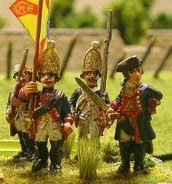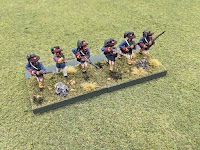For the Confederates, we had Rob and new-to-Electronic Brigadier player John. On the attacking Union side, Veteran players Phil, Kevin and Byron.
The obligation to attack is on Caldwell's 1st division shown here in the foreground. They must drive the surging Confederates from the Wheat field, oat field and back through the woods behind both. Although the Union have a significant advantage in numbers, there are some challenges bringing everything to bear in a coordinated attack. In our play test, Ed M did this marvelously, but also had the benefit of sole command of all of the Union forces.
Here about mid-game Byron's attack has carved a significant hole in the Confederate line, driving one of the Georgian regiments back. While Rob tries to rally them, John denies flank in the center preventing Byron from following up. John also brings in a large South Carolinian regiment from his reserve just in time. As seen Phil's large green Pennsylvanian regiment charges through the Oat Field (left in the open) but was subsequently repulsed. John's follow-up counterattack driving the green regiment back over the artillery. At game conclusion John captured one section of guns on the road. Byron and Kevin conducted one final coordinated attack on the Confederate right flank. This attack included some fresh reinforcements from Kevin's command. Unfortunately for the Union, the defending Georgians had just enough punch left in their defensive fire to force a firefight from most of the smaller attacking units, breaking up the attack and allowing the larger Georgia regiment to turn the one regiment that made it into close combat away.A well played affair by both sides with one charge in particular being a very fortunate roll of the virtual dice in the melee resolution. The plucky confederate defenders turning a larger Union unit away with a roll of 97 (out of 100) vs a roll of 12. Anything less than this and I'm sure the union would have broken a second hole in the Confederate line securing a much different outcome! Next time I'll run this scenario will be Saturday Morning at the Mayhem convention during the Saturday morning session.






















































